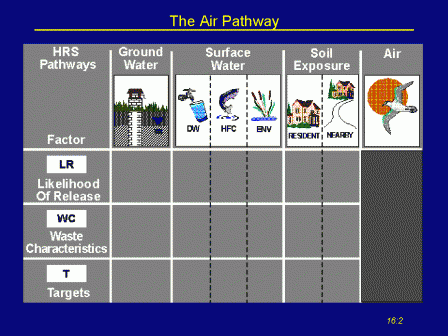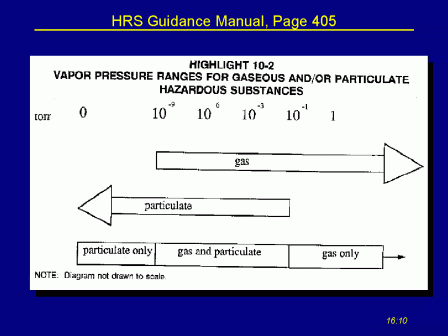Section 16: Air Pathway - Likelihood of Release

16.1 Observations
- It is rarely beneficial to score the air pathway in areas of low population density.
- Due to distance-weighting, the air pathway score is frequently very low in the absence of an observed release.
- Determining an air pathway score is straightforward, particularly as an adjunct to scoring the soil exposure pathway.
- Data from health and safety sampling can frequently be used to:
- support an observed release through direct observation
- provide evidence of biogas release
Outdoor Air Restriction
- The air pathway addresses releases to the outside atmosphere only.
- Indoor air contamination data can be used to support an outside observed release by chemical analysis.
- Indoor air contamination cannot be scored using the air pathway except in terms of its potential to escape into the outside air.
- Buildings containing indoor air contamination located on a site can be considered sources in certain circumstances. Consultation with EPA is necessary in such circumstances.
- Interstitial air spaces in soil is not considered to be part of the outside atmosphere.
Gaseous and Particulate Substances
- Distinguish between gaseous substances (vapor pressure greater than or equal to 10-9 torr) and particulate substances (vapor pressure less than or equal to 10-1 torr).
Highlight 10-2
Vapor Pressure Ranges for Gaseous and/or Particulate Hazardous Substances

16.2 Likelihood of Release
Observed Release by Direct Observation
- An observed release by direct observation can be documented when one of the following occurs:
- Material that contains one or more hazardous substances has been seen entering the atmosphere directly.
- Demonstrated adverse effects may establish an observed release when evidence documents that a material containing hazardous substances has been released into the atmosphere.
- Documentation that the material contains hazardous substances is essential. Such documentation includes: sampling data (e.g., dust samples from piles) and documentary evidence (e.g., permits and compliance records).
- Observed releases by direct observation can usually be established near any permitted air emitting facility.
Observed Release by Chemical Analysis
- An observed release to the atmosphere (outdoor air) by chemical analysis is documented when both of the following occur:
- Analysis of air samples shows that the concentration of ambient hazardous substance(s) has increased significantly over background for the site.
- Some portion of the release is attributable to the site.
- Establishing an observed release to air through chemical analysis is difficult due to the variability of the atmosphere. Specialized expertise is needed to design and execute air sampling programs.
- Methane and similar "landfill gases" are not hazardous substances and cannot be used to establish an observed release through chemical analysis.
Special Considerations for Air Sampling
- Determination of wind direction during sampling is essential
- "Background" can be determined using an upwind or cross-wind sample.
- Longer sampling durations increase likelihood of release detection but also increase likelihood of changes in wind direction.
- All air samples must be comparable:
- taken duration the same, approximate time period
- taken at the same elevation relative to sources at the site
- collected using comparable equipment under comparable operating conditions (e.g., sampling duration)
- analyzed with comparable equipment
- Air sampling is not restricted to the "bearing zone."
- Soil gas samples cannot be used to demonstrate a significant increase above background level.
- Soil gas samples can be used to support attribution.
- In special circumstances, health and safety sampling can be used to establish an observed release through chemical analysis. Special attention must be given to sampling QA/QC in such cases.
- EPA has prepared specific guidance to support air pathway analyses in the Superfund program: List of Guidances
Potential to Release
- In a single source, there may be some substances that are gaseous, some substances that are particulate, and some that are both.
- The release of gaseous substances is governed by different processes than the release of particulate substances. Therefore, two separate evaluations are needed.
- Separate calculations are performed for each source.
- For purposes of potential to release evaluations, sources with similar characteristics can be aggregated to form a single "source."
- same containment factor value
- same source type
- significant overlap in hazardous substances
- Combining sources is advantageous for small sources or for purposes of expediency
- Factors
- Containment
- Source Type
- Migration Potential
Gas Containment
- The gas containment value is assigned from HRS Table 6-3.
- These tables require that specific observations are made during the site visit.
- Critical Source Features
- depth of uncontaminated soil cover
- extent of vegetation
- releases of biogas (e.g., methane)
- active fires
- condition of containers
Gas Source Type
- The gas source type factor value is assigned from HRS Table 6-4.
- Different gas and particulate source type factor values may be assigned to any particular source.
- The minimum size requirement applies to source type rather than containment in the air pathway.
- If a source does not meet the minimum size requirement (i.e., a hazardous waste quantity value of 0.5 or greater), assign that source a value of 0 for both source type factors.
- Evidence of releases of biogas (e.g., methane) substantially increases the source type value for containers/tanks, landfills, and buried surface impoundments.
Gas Migration Potential
- Obtain the gas migration potential value for each gaseous substance found in the source from the Superfund Chemical Data Matrix (SCDM).
- EPA should be consulted whenever values are needed for substances not appearing in SCDM.
- Take the average of the three highest values.
- Assign a source gas migration potential to the source from HRS Table 6-7.
Gas Potential to Release
- For each source, sum the gas source type factor value and gas migration potential factor value and multiply this sum by the gas containment factor value.
- Select the highest product calculated for the sources evaluated and assign it as the gas potential to release value for the site.
Particulate Containment
- The particulate containment value is assigned from HRS Table 6-9.
- These tables require that specific observations are made during the site visit.
- Critical Source Features
- depth of uncontaminated soil cover
- presence of liquids
- extent of vegetation
- condition of containers
Particulate Source Type
- Different source type factor values are assigned to gas and particulate potential from HRS Table 6-4.
- The minimum size requirement applies to source type rather than containment in the air pathway.
- If a source does not meet the minimum size requirement (i.e., a hazardous waste quantity value of 0.5 or greater), assign that source a value of 0 for source type.
Particulate Migration Potential
- This value is the same for all sources at the site and is based on the location of the site.
Particulate Migration Potential Factor Values, Figure 6-2
- If the site is not located on the map or is too near a boundary on the map, calculate the Thornthwaite precipitation-effectiveness index using mean monthly precipitation and temperature data for the site.
Particulate Potential to Release
- For each source, sum the particulate source type factor value and particulate migration potential factor value and multiply this sum by the particulate containment factor value.
- Select the highest product calculated for the sources evaluated and assign it as the particulate potential to release value for the site.
Overall Potential to Release
- The overall potential to release value is the higher of the gas and particulate potential to release values.
Navigate to another section of the course:
| Table of Contents | |||||||||
|---|---|---|---|---|---|---|---|---|---|
| 1 | 2 | 3 | 4 | 5 | 6 | 7 | 8 | 9 | 10 |
| 11 | 12 | 13 | 14 | 15 | 16 | 17 | 18 | 19 | 20 |
